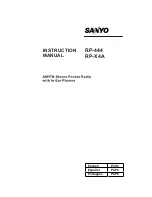
G U A R D I A N V H F 1 1 0 W M O B I L E
8-1
CHAPTER 8: DEFINITIONS
Alert Mode
: Display and audio properties are used when the emergency key is pressed. In normal mode, the display
flashes EMERGENCY and an audio tone is heard. In silent mode, the display is blank and no audio tone is heard.
Analog-to-Digital Converter (ADC)
:
An electronic device for converting data from analog to digital form for use
in electronic equipment.
Backlight
: The light behind the keypad and LCD enables the keys and LCD to be visible in dark conditions.
Backlight Delay
: The time the backlight remains on after the last keypad activity.
Bandwidth (BW)
: A small range of frequencies around a transmit or receive frequency in which a message can be
received or transmitted.
Bank
: A group of zones. There are up to 4 banks per radio. Up to 16 zones can be distributed through these
4 banks.
Channel
: A memory location with defined receive, transmit, squelch, modulation, and power settings. There are
256 channels per radio.
Channel Locked
: An indicator informing that channel settings cannot be programmed using the LCD and keypad.
The settings can only be changed using the PC programmer.
Channel Scan
: Scans all channels on the scan list in a given 16-channel zone. The scan starts on the home channel,
checks each channel in the scan plan, returns to the home channel, and then scans each channel in the scan plan.
Common Air Interface (CAI)
: The CAI standard allows interoperability within any Project 25 system provided
they are all in the same frequency band.
Continuous Tone-Controlled Squelch System (CTCSS) Tone
: A sub-audible tone superimposed on an analog
signal to reduce interference from traffic and background noise.
Digital Coded Squelch (DCS)
: A digital variable superimposed on a digital signal to reduce interference from
traffic and background noise.
Digital Signal Processor (DSP):
Handles all signal-processing functions.
Digital to Analog Converter (DAC)
: A device that takes a digital value and outputs a voltage that is proportional to
the input value.
Dual-Tone Multiple-Frequency (DTMF)
: A signaling scheme used by the telephone system in which two-voice
band tones are generated for each keypad key press.
Global Search
: Scans all frequencies programmed into the radio, regardless of scan list designation.
Initial Synchronization
: The length of time required for the radio to perform encryption synchronization.
Microprocessor Unit (MPU):
A computer’s entire CPU is contained on one (or a small number of) integrated
circuit.
Monitor Receive Squelch
: The radio receives any intelligible analog transmission.
Monitor Timer
: The amount of time the radio stays on a channel picked up during the scan and before the radio
reverts back to scan mode.
Network Access Code (NAC)
: Selective squelch for digital mode. The primary purpose is to allow the user access
to a repeater network. In radio-to-radio communications, these codes are used to eliminate interference from other
traffic and background noise.
Normal Receive Squelch
: The radio receives any transmission having the correct NAC.
Priority 1 Scan
: Priority 1 channel is sampled during scanning, receive of an active channel, or standby. Activity
on the priority1 channel overrides all other modes except emergency.
Содержание G25AMK005
Страница 2: ......
Страница 8: ......
Страница 30: ......
Страница 60: ......
Страница 62: ...7 2 G U A R D I A N V H F M O B I L E...
Страница 66: ...9 2 G U A R D I A N V H F M O B I L E...
Страница 69: ...G U A R D I A N V H F 1 1 0 W M O B I L E 11 1 CHAPTER 11 SCHEMATICS...
















































